Intel Unveils New Low-Cost PC Platform: Apollo Lake with 14nm Goldmont Cores
by Anton Shilov on April 15, 2016 6:00 PM EST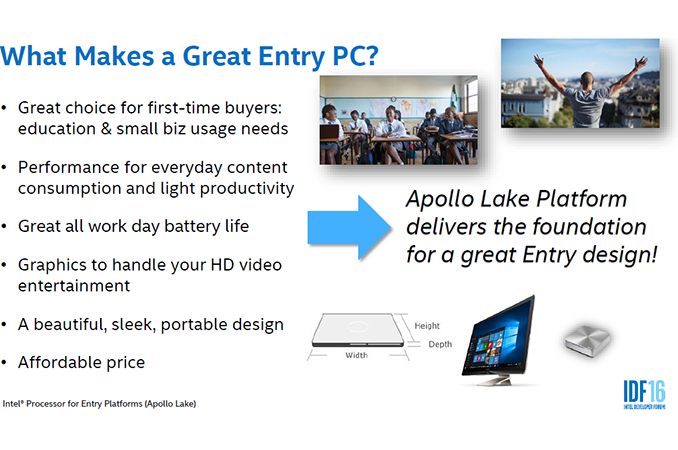
This week, at IDF Shenzhen, Intel has formally introduced its Apollo Lake platform for the next generation of Atom-based notebook SoCs. The platform will feature a new x86 microarchitecture as well as a new-generation graphics core for increased performance. Intel’s Apollo Lake is aimed at affordable all-in-ones, miniature PCs, hybrid devices, notebooks and tablet PCs in the second half of this year.
The Apollo Lake system-on-chips for PCs are based on the new Atom-based x86 microarchitecture, named Goldmont, as well as a new graphics core that features Intel’s ninth-generation architecture (Gen9) which is currently used in Skylake processors. Intel claims that due to microarchitectural enhancements the new SoCs will be faster in general-purpose tasks, but at this stage Intel has not quantified the improvements. The new graphics core is listed as being more powerful (most likely due to both better architecture and a higher count of execution units), but will also integrate more codecs, enabling hardware-accelerated playback of 4K video from hardware decoding of HEVC and VP9 codecs. The SoCs will support dual-channel DDR4, DDR3L and LPDDR3/4 memory, which will help PC makers to choose DRAM based on performance and costs. As for storage, the Apollo Lake will support traditional SATA drives, PCIe x4 drives and eMMC 5.0 options to appeal to all types of form-factors. When it comes to I/O, Intel proposes to use USB Type-C along with wireless technologies with Apollo Lake-powered systems.
| Comparison of Intel's Entry-Level PC and Tablet Platforms | ||||||
| Bay Trail | Braswell | Cherry Trail | Apollo Lake | |||
| Microarchitecture | Silvermont | Airmont | Airmont | Goldmont | ||
| SoC Code-Name | Valleyview | Braswell | Cherryview | unknown | ||
| Core Count | Up to 4 | |||||
| Graphics Architecture | Gen 7 | Gen8 | Gen8 | Gen9 | ||
| EU Count | unknown | 16 | 12/16 | unknown (24?) | ||
| Multimedia Codecs | MPEG-2 MPEG-4 AVC VC-1 WMV9 HEVC (software only) VP9 (software only) |
MPEG-2 MPEG-4 AVC VC-1 WMV9 HEVC (8-bit software/hybrid) VP9 (software/hybrid) |
MPEG-2 MPEG-4 AVC VC-1 WMV9 HEVC VP9 |
|||
| Process Technology | 22 nm | 14 nm | 14 nm | 14 nm | ||
| Launch | Q1 2014 | H1 2015 | 2015 | H2 2016 | ||
From the IDF presentation, Intel shares only a few brief details regarding its new Apollo Lake design platform, but does not disclose exact specifications or performance numbers. At this point, based on 14nm Airmont designs, it is pretty safe to assume that the new SoCs will contain up to four Goldmont cores in consumer devices but perhaps 8+ in communications and embedded systems. Intel has not specified the TDP of its new processors but claims that power management features of the platform will help it to improve battery life compared to previous-gen systems (which might point to a Speed Shift like arrangement similar to what we see on Skylake, perhaps). While Intel does not reveal specifics of its own SoCs, the company shares its vision for the upcoming PCs powered by the Apollo Lake platform.
Firstly, Intel believes that the upcoming affordable PCs, whether these are all-in-one desktops, miniature systems, 2-in-1 hybrids, laptops or tablets, should be very thin. According to their market research, this will make the devices more attractive to the buyer, which is important. To make systems thinner, Intel traditionally proposes to use either M.2 or solder-down eMMC solid-state storage options instead of 2.5” HDDs/SSDs. In addition, the company believes that it makes sense to use solder-down Wi-Fi, instead of using a separate module. Intel seems to be especially proud with the compactness of the Apollo Lake SoC (as well as other core components) and thus the whole platform, which is another factor that will help to make upcoming systems thinner. For the first time in recent years, Intel also proposes the use of smaller batteries, but devices can maintain long battery life by cutting the power consumption of the entire platform. While in many cases reduction of battery size makes sense, it should be noted that high-resolution displays typically consume a lot of energy, which is why it is hard to reduce the size of batteries, but maintain the visual experience along with a long battery life.
Secondly, PCs based on the Apollo Lake should be very affordable, which is why Intel’s reference core components design can be used for different form-factors (AiO and mobile). Additionally, the company reveals a number of BOM (bill of materials) savings opportunities, which are a result of higher level of SoC integration as well as a recommended choice of components. In the slide above, using all the savings can make a difference in BOM for between $5.55 and $7.35, which could mean double memory or a better display for the same price for the new generation.
Intel’s reference design for Apollo Lake-based PCs seems to be a tablet/2-in-1 hybrid system with an 11.6” full-HD (1920x1080) 10-point multi-touch display, 4 GB of LPDDR3-1866 memory, 64 GB M.2 SATA3 SSD or 32 GB eMMC storage, an M.2 wireless module supporting 802.11ac, an optional M.2 LTE modem, an integrated USB 2 camera, a host of sensors (accelerometer, ambient light, proximity detection, and magnetic switching) as well as a USB Type-C connector supporting USB power delivery and alternate modes. Such reference design can power not only mobile, but also Aan IO and even small form-factor desktop PCs. Still, given the fact that we are talking about low-cost systems, do not expect retail computers to feature multiple storage devices and LTE modems. However, PC makers may opt for more advanced displays as well as better integrated cameras, or an SI might plump for a half-price 'Macbook-like' device design using Type-C, albeit on the Atom microarchitecture. This is Intel's vision forthe next generation of Chromebooks: the 'cloud book' market.
PCs based on Intel’s Apollo Lake platforms will emerge in the second half of the year and will carry Celeron and Pentium-branded processors. At present, entry-level notebooks (which Intel calls Cloudbooks) offer 2 GB of memory, 32 GB of storage, 8+ hours of battery life and ~18mm thick designs. With Apollo Lake, OEMs should be able to increase the amount of RAM and/or storage capacity, make systems generally thinner, but maintain their $169 - $269 price-points. Intel also believes that its Apollo Lake presents great opportunities to build 2-in-1 hybrid PCs (convertibles) and capitalize on higher margins of such systems.
Traditionally, Intel discusses options and its vision, but not actual PCs, at its IDF trade-shows. It remains to be seen whether PC makers decide to build low-cost convertibles or ultra-thin notebook designs, or will stick to more traditional clamshell notebooks. In fact, we will learn more about BTS (back-to-school) plans of major PC OEMs regarding Apollo Lake at the upcoming Computex trade-show in early June. There's also IDF San Francisco in August where Intel may open some lids on how the new Goldmont core differs from Airmont.
Source: Intel


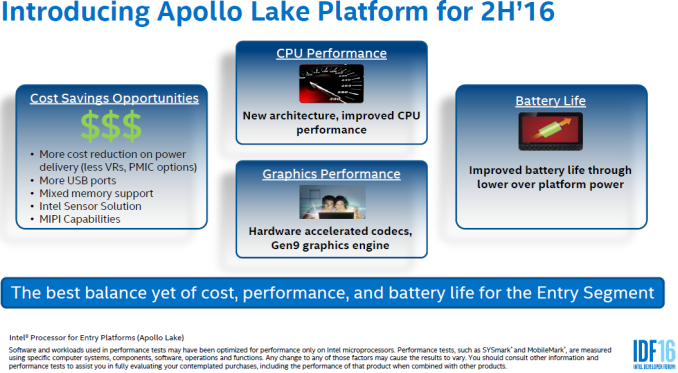
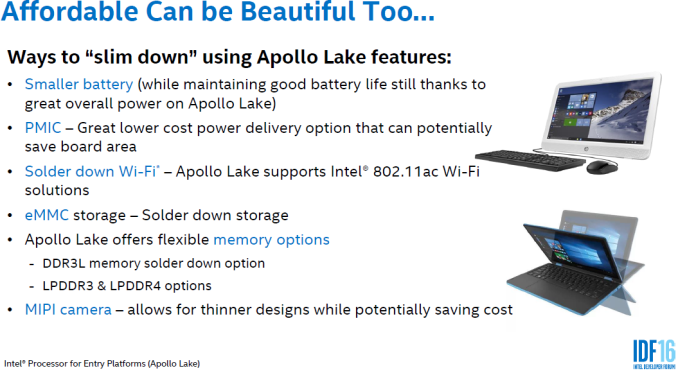
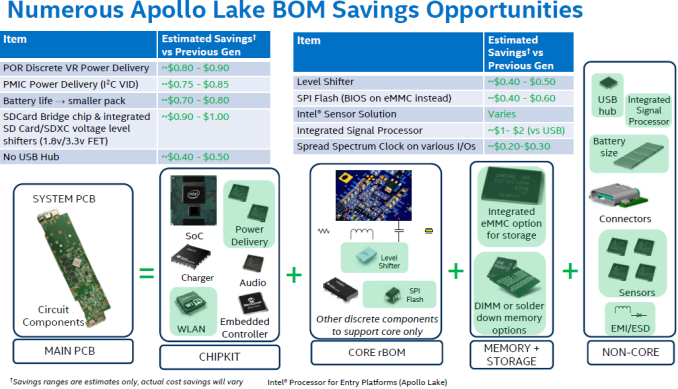
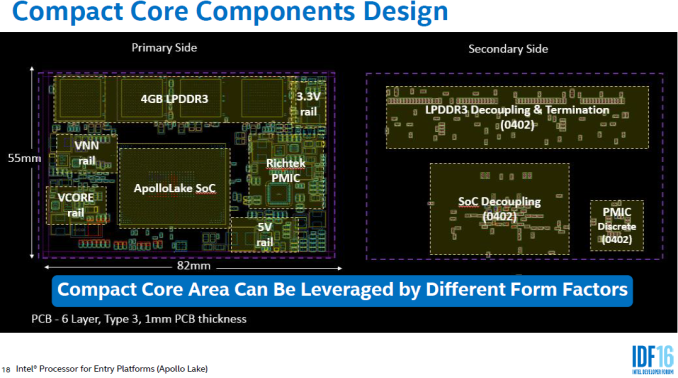
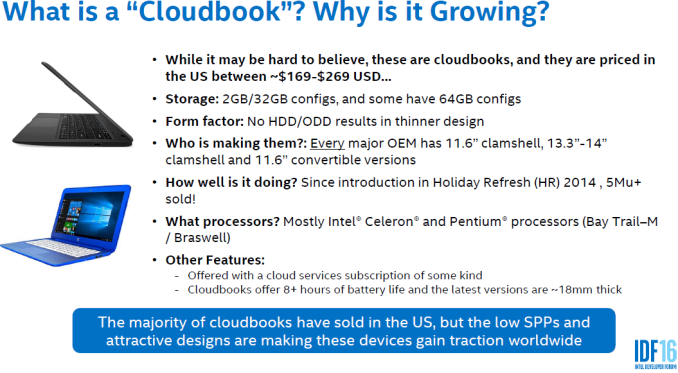
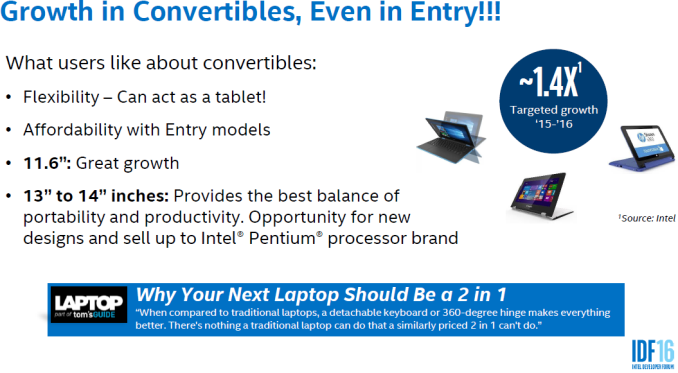














95 Comments
View All Comments
patrickjp93 - Tuesday, April 19, 2016 - link
No you can't, because the gains have been huge. The problem is software not keeping up with new instructions that do more. All the big-iron servers swap chips every year, so clearly performance gains are there.paddytokey - Friday, April 22, 2016 - link
SSDs also make for a very valid upgrade option to bring back new life to older notebooks, I made a lot of people hold off from buying a new laptop just by installing an SSD.haukionkannel - Saturday, April 16, 2016 - link
Chromebooks Are the biggest winners at this moment so ofcourse Intel try to compete with those. People don,t need anything more powerfull that chromebooks at this moment, so the faster Computer sales is declining. There Are some minor market segments that would like to have faster computers. Gamers, and video content makers and some computational task.For those gamers is so minor, that They can be ignored. The others can use 24 core pro prosessors, because the price is not a problem.
So cloudbooks is the segment where you can Expect more sales if the price is right!
BurntMyBacon - Monday, April 18, 2016 - link
@haukionkannel: "For those gamers is so minor, that They can be ignored."DON'T IGNORE ME!!!
(We can be very vocal and you know what they say about the squeaky wheel)
haukionkannel - Tuesday, April 19, 2016 - link
And what new and exiting gamers has got during the last 5 years from CPU department... Hmm... nothing... And I have not seen any signs that Intel is worried about that.We are minority, that has no meaning at all...
LordConrad - Saturday, April 16, 2016 - link
I think Intel is saying "cloudbooks" because they don't want to endorse individual companies. Chromebooks are the obvious connection, and they have been selling very well, especially in schools and to people who don't need or want full-blown computers.otherwise - Monday, April 18, 2016 - link
"Cloudbook" is just a vendor-agnostic way of saying "Chromebook".rahvin - Tuesday, April 19, 2016 - link
Hate to break it to you buddy but Intel isn't pushing the "cloudbook" and never has. Google invented this market segment and nearly every sale is a Chromebook. Both Intel and Microsoft laughed when Google introduced the machines. Microsoft stopped laughing about 2 years ago when they realized how many had been sold. I'm actually surprised that only 5 million have sold. Chromebooks occupy at least one sometimes all three of the top sales spot on Amazon for laptops.Chromebooks are real, sell quite well and for a lot of people they are the only computer they need. This presentation slide is Intel finally admitting the segment is real, just like Microsoft did when they created the HP Stream as a counter.
pugster - Tuesday, May 31, 2016 - link
Not really Intel's fault that the pc shipments are down. Rather companies like Microsoft and Google didn't raise hardware requirements, instead maintaining hardware requirements for Windows and Android OS. I have an Intel Z3735F tablet and it works really great despite having 2gigs of memory and 32gb emmc disk. Intel really flupped it up on the Z3735G by crippling it with 1gb of memory and you can't really run windows with it.There are always entry level buyers who just want to surf the web and read emails and 32gb emmc is good enough for them. Ultrabooks are nice, but kaby lake cpu's cost 10x more than Apollo lake SOC's and it is cannibalizing sales of their entry level products.
Intel's Apollo Lake SoC's are made to compete with the mobile/higher end ARM market. The problem with Intel is that they couldn't compete with ARM SOC's in the mobile market.
BobSwi - Friday, April 15, 2016 - link
netbook v2, prolly be good for a spot of ole linux. Hopefully less hoops to jump through than chromebooks have.